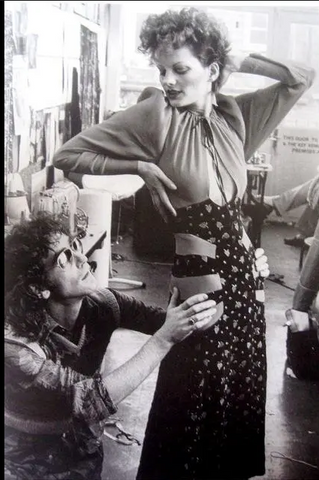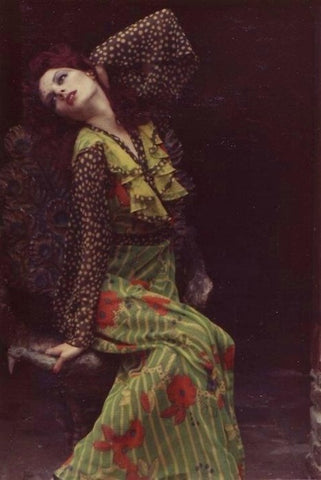OSSIE CLARK AND THE SWINGING LONDON

Ossie Clark was one of the leading stylists of Swinging 60’s London, the center of fashion and youth culture, together with Mary Quant, Barbara Hulanicki (Biba), Emmanuelle Khahn, and Zandra Rhodes.
Born in Liverpool and versatile since childhood, he made clothes for his nephews and nieces and swimwear for the neighborhood girls, practicing on dolls. A fervent reader of Vogue and Harper's Bazaar, he began studying architecture at thirteen. This proved decisive in his future career as a stylist, as he declared later, as it allowed him to understand the basics of proportions and volumes.
He enrolled in the Manchester Regional College of Art (now Manchester Metropolitan University), where he met his future wife and working partner, Celia Birtwell. Later, the couple moved to a small flat in the Notting Hill area of London, where Ossie graduated from the Royal College of Art in 1965.
In August of the same year, one of his creations appeared for the first time in Vogue. Influenced by Pop Art and Hollywood culture, Woollands 21 was the first shop to sell his creations.
In 1966, the collaboration between Ossie and Celia began (married three years later), with prints designed by the latter, giving life to a remarkable collection commissioned by Alice Pollock, owner of the exclusive boutique Quorum, frequented by the golden youth of the London pop scene. In a short time, Ossie Clark's creations, so special and unique at the time, gained popularity in the Swinging 60’s London, of which he was the absolute protagonist and in New York.
Among his fans was Mick Jagger, introduced by Quorum, for whom he designed a series of innovative elasticized printed suits, thus starting a collaboration with the Rolling Stones and the world of Rock, which would last for years. Between Marianne Faithfull, Liza Minelli, and many others… he and Celia translated the Pop style into clothing that women really wanted to wear.
Famous are the photos of David Bailey, among whose many muses were Jane Birkin and Celia Birtwell herself. His romantic and “floating” clothes resulted from extraordinary free-hand cutting work; the plunging necklines, the marked waist, the graceful silhouettes, and the mix of prints have left an indelible mark in the history of fashion.
It seems that Clark was obsessed with being able to dress all kinds of women, even those about to give birth: "Comfort is the only thing that matters," he said. The Henri Bendel department store in New York also bought Clark's creations, making him the first British designer to export his clothing. However, in the late 1960s, despite the successes, the company found itself heavily indebted. So he decided to sell Quorum to the fashion house Radley, through which Clark's creations were then sold. He reorganized the business by planning a progressive expansion of the sale of products designed by Clark, and in 1968 the first diffusion line for Radley was born under the name of "Ossie Clark for Ridley.”
In the seventies, lifestyle choices and a style seen as too hedonistic triggered a downward spiral despite his clothes appearing in major fashion magazines and being portrayed by photographers of the caliber of Helmut Newton. In 1975, Radley prèt-a-porter decided to start mass production of the couture of Clark’s designs, making mistakes and failing. Ossie and Celia divorced; Clark suffered a severe nervous breakdown, aggravated by his chronic addiction to psychiatric drugs.
Ossie Clark restarted the business in 1977 with new partners Tony Cadler and Peter Lee, but the collaboration lasted only two years. After a long period of oblivion, he tried to return to the limelight in the mid-eighties by reconnecting with Radley; his old muses marched on the catwalk to draw his attention: Marie Helvin and Jerry Hall. But lack of interest in the press and lack of funds soon led to another breakdown.
In the last few years, Ossie Clark has found balance in Buddhism and, although far from the inner fashion circles, continued to make garments for private clientele. He was murdered in 1996, at the age of fifty-four, by a former lover.
He left an extraordinary legacy in fashion, both for the innovative use of printed fabrics and his original idea of freedom and modern romanticism that anticipated and characterized the Hippie style.
His clothes have influenced several designers from the 1960s to the present day, such as Anna Sui, Tom Ford, and Yves Saint Laurent. Some of these are highly sought after and have reached an inestimable value.

Jim Lee - Ossie Clark - Plane Crash - 1969

Ossie Clark working with Celia Bitrwell

Nicky Samuel wearing Ossie Clark - Vogue 1971

Bianca Jagger wearing Ossie Clark

Gala Mitchell in Ossie Clark dress - 1969

Ossie Clark fashion show Chelsea Town Hall - 1970

Jane Birkin wearing Ossie Clark

Amanda Lear wearing Ossie Clark

Mick Jagger wearing Ossie Clark - photographed by Ken Regan - 1972

Mr and Mrs Clark with Percy - Artwork By David Hockney



